#or forced sterilization because they think my life (and thus any life i may create) is worse than worthless?
Text
listen im sure your comeback on a vile post is hilarious and great but before you post it, ask yourself is it necessary to put that type of gross post on your page—somewhere where you want that targeted group of people to feel safe? yea i get the reason you're reblogging it is because you think youre sooo funny and clever and youre disagreeing with the initial post so you think it's fine. but at the end of the day you're still spreading that harmful ideology and are exposing it to the people you're trying to protect or defend.
#i dont want children. i dont plan to ever have children. but seeing someone say im too retarded to make that decision and support eugenics#or forced sterilization because they think my life (and thus any life i may create) is worse than worthless?#not fun! i don't give a shit about your joke!#yeah i get youre reblogging that e/d post to say hey being fat is good but youre still spreading e/d shit.#yeah i get youre trying to be supportive of lgbt people but youre still spreading terf's posts.#youre still spreading posts by antisemitics and racists and bigots and transphobes and ableists and etc and etc.#your little comeback isnt funny enough to take away the potential damage and pain that the main post can cause.#ransom note
5 notes
·
View notes
Text
How to Build a World?
Some time ago, I answered a writing question as Quoth the Raven that dealt with how to go about Worldbuilding for your story (Found Here). I’ve now rewritten the piece because I was struck with inspiration for a much more poetic form. I rather like it this way...
______________________________________________________________
Every story has to start somewhere. Some start with an endless void, a dark abyss where spirits drift over the waters, an egg which has not yet hatched to reveal the universe contained within. But in my opinion the best beginnings are found on a blank page.
Sing an ode to the whiteness of a screen, to the sterile form of an unfilled notebook amidst a pile of notebooks you keep buying but never write in. I call upon thee, oh Muses, let the divine speak into the shadows and let there be light. Fountains may spring up from the deeps and the oceans pay homage to the moon above. I am but a humble supplicant to the gods of paper and ink, where multiverses of verse and prose are crafted from words alone.
A world must be made through the number seven. Seven days, seven dwarfs, seven epochs, seven sins, seven virtues, seven founding principles of building a world.
The First is of Magic. All worlds begin with magic in a way. You can call it by any name you desire; Nature, physics, deity. First a word is spoken, a rule, a way of being. Whether the universe is filled with blinding empty light and shaded to sight by suns of shadow and fires that burn black enough to repel the light of night, or if the endless skies are oceans where planets drift in bubbles of air and stars keep the endless ice of the galactic abyss at bay with their warmth.
It is a question of how your world works, a list of rules that cannot be broken by even you as the rest of the pieces fall into place. A willing suspension of disbelief is a fragile thing. If it breaks, you are dashed to pieces beneath the weight of fallen expectations. A reader betrayed is rarely forgiving to those who have broken their own laws.
So write, write of the shifting of stars and the fundamental forces of love and duty. In your canon proclaim the laws of wind and gravity, atoms of justice, and the blessed radiation of whimsy and wonder.
But once you have finished, and the last law carved upon the last stone atop your own Sinai, you must heed them always. From gods to grains of sand on a distant shore, none can break these commandments.
When you speak a second time, it is of Place. Of mountains and mayhem, of vast oceans where secrets lie forgotten far beneath the waves.
Reach out your hand to carve canyons from the paragraphs on the page, riverbeds that flow swift and pure into great lakes and down into silent aquifers below the very earth itself. Whether one sun, or seven, or none at all, this world must be made known through careful descriptions and prose.
And as long as it does not contradict your rules, you can have islands that fly through the skies, glass rain, giant geodic structures that have never seen the light of a single day. What of glaciers that chill the whole land into an ice age? Or a supervolcano that belches molten glass from its summit?
Then, as your world is forming, think on the third principle of building a world. Life.
Deep down in the depths of the darkest seas you might form creatures so alien they defy the very mind, drifting on currents and living without sun or sky, only in eternal shadow and crushing pressure. Or you may begin on land instead, with green skinned goblin-like folk who live among the trees and speak in song and melody as they hunt the fire breathing dragonflies. Perhaps even the sky might be your dominion. Pods of whales that swim among the clouds, blowing geysers of wind high into the abyss of blue and white that turns to stars at the highest heights.
Each living thing lies in connection with one another. Eating, growing, changing, moving. Flowers make bioluminescence in forever darkened woods and caverns. Gas filled balloon-like pods could carry creatures high into the sky with them, letting them escape from predators.
Here and now your pen is the fountain that begets creation, your mind is the tree from which all life springs. This world is your garden to cultivate, your Eden cradled between life giving rivers.
Wherever you touch there will be life. In the most scorching of deserts, in the deepest caves and wells, in the furthest canyons, upon the coldest glaciers.
And as long as you remain true to your rules of reality, your world can take even the most whimsical of forms. Trees whose roots tangle among the clouds and whose boughs hang down towards the distant earth below, people who can see colors that neither you nor I have ever heard of. Each new thing makes your world more complex, more real, more connected.
Perhaps you know what comes next? In truth it has already begun, for your fourth is of Cognition.
It may be that somewhere in your world there is a creature or plant, perhaps many, or even all, who have tasted that forbidden fruit and became more than they were, became aware that their eyes had been closed and for the first time knew that they could open them and look.
What might it be like? To look out at the world and for the first time see it anew? Before there was survival and safety, food and mating. There was no time for beauty, no time for dreaming, no time for such things when every moment was needed. Yet at some point, there was time, and someone stopped to look. And everything changed.
Most creators prefer the humanoid form when building cognizant peoples, though not all, some few might choose different shapes. Plant, reptile, insect, or even stranger forms the likes of which might not be found here in our world, but only in that world of their making.
But the shape isn’t the important thing. No, what is vitally important is the manner of cognizance. How is it that your people understand the world? What are they aware of? What things can they hear? Or touch? Taste? See? Smell? Or perhaps they have senses that can only be described in roundabout ways to readers who will never entirely understand what it is to perceive in such ways, like blind men who try to know what it is like to see.
Now it is time at last for your fifth. This is the culmination of all things thus far, the laws of reality, the geography, the life, the cognizant peoples… Your fifth is Culture.
Peoples gather together. They make laws to protect or to divide, to ensure and ensnare. They farm or hunt for food, creating new ways with new generations. And best of all they tell stories. Oh those stories. These are the things of which culture is made. Stories that are woven into tapestries or painted into murals, songs are composed to evoke the emotions of such stories, even food is cooked to be eaten as the stories are told.
But there are other things which can affect your peoples and persons. Where do they get their clothing? Animal hides or plant fibers? Perhaps wool or cotton? And how is it obtained? Technology? Magic? Labor? Do the people even wear clothing at all? For some might not find it necessary if they are perfect for the place they dwell in their world.
What foods can they eat? Would you or I even recognize it? Let alone be able to digest it without agonizing pains in our stomachs? A fruit that glows might transfer its glow to those who eat it, giving them light to see in the dark and energy to live another day. Certain beasts are only slaughtered on certain days of the star calendars, for festivals and holy feast days, for ceremonial reasons and never secular ones.
Here is the most dangerous part in your journey, for the building of culture can become a mire or a maze, a labyrinthine pit from whence you can never escape no matter how much you build. Every detail begets another, and cultures are more than any one person can make. World Builder though you are, you still have limitations of your own.
So you look to the sixth, which is history. From whence did they come? And where do their journeys go? And of course, what happened at every step in between? Kings and emperors to the feuds of petty farmers. Did the dragons lay claim to the seven clawed mountains in the forty ninth century or did the Arch Astronomer falsely claim they did so that he might turn his people’s thoughts to southern trade?
Culture takes time to move and once it begins it will not stop. From the grand world point of view to the shortsightedness of individuals, each and every step will be important. Religions and wars, cataclysmic events, heroes, and even plagues. Everything that arises when you add time to the world you have created is history. The world is a living breathing thing that will move on its own if you let it.
The seventh day arrives. Some deities might rest, seeing that all is good. But not you, for your world is made in slavish worship to the Story. A world built so that it might contain, for good or ill, a tale of your telling.
So write, prideful one. Your hubris has driven you to follow in the footsteps of the gods themselves, building a world where before was nothing. It is time to look closer, to follow a single strand of thread in this tapestry you have woven from dreams and shadows.
Now that you have crafted for us an entire world, tell us your tale. We are listening.
#quoth the raven#writing#worldbuilding#prose#worldbuilder#creation#worlds#7#seven#rewrite#how to build a world
35 notes
·
View notes
Text
My partner was drawing fanart for a show they like. I overanalyzed it. They wanted me to share. This post is very long.
The show is called Bolts and Blip. It was made in 2010, and ran just one season into 2011. The initial premise I was told was that robots competed in sports on the moon to solve disputes that happened on earth.
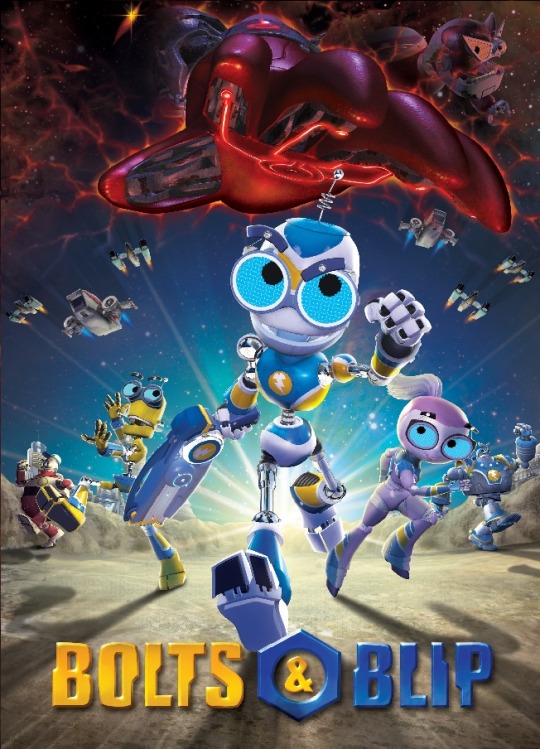
Initially I thought this was an odd way for democracy to operate, but hey, I don’t make decisions for the government, so moon robot sports is how things were.
This intrigued me for a few reasons, such as
It takes place in a post-war era of “world peace”, in approximately 2080. Judging how things are going now, I find the concept of 2080 being after a world war very believable.
There was seemingly one democracy on earth now, and that democracy decided unanimously to settle all further disputes via moon robot sports, as stated.
Humanity was technologically advanced enough at this point to not only create robots that could play sports, but they played these sports in a large city on the moon!
My initial question was this: Do we know who built the robots?
Yes of course, its common knowledge on the moon. Just two scientists are responsible for all the robotic life on the moon, creating a number of robots in the ballpark in the thousands. This is a lot of moon robots.
There is a need for so much raw material to create even a thousand robots, enough for a civilization, NOT TO MENTION the massive city they all inhabit. Where they probably don’t get new shipments of materials on the reg, this would mean the scientists could continue making more until they ran out of resources.
However, besides these main robots, one of the scientists also created a race of at least 100 robot leprechauns living under the ground. Or, at least... One of the leprechauns.

Then, allegedly, this one robot created more than a hundred more. I do not know when the first robot leprechaun was created, but I fear for the safety of the human race if there was any interplanetoid travel between the earth and the moon while they existed.
The resources sent to the moon for the purposes of making robots would be very finite. Thus, if these scientists created the robot leprechauns before they had used the resources up, the leprechauns could apparently self replicate using the materials on the moon. This is how there became more than a hundred of them.
This may not be the case, but if a single one of the sublunarean self replicating leprechaun robots happened to board a spaceship that was heading for Earth... With a near infinite supply of resources, enough to spare on moon robot sports, the number of leprechaun robots would quickly grow. The earths infrastructure could be at risk. I’m talking sinkholes that are miles wide. Why?
Because the leprechauns were programmed and built for the moons gravity. The leprechauns create more of themselves on earth, as many as they are able to, but are still programmed for the moons gravitational density. The Earth is much heavier, and when the build their subterranean halls, they would not know that our planets density is more prone to collapse. Catastrophe.
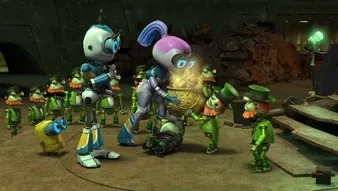
But even that is purely conjecture, because Earth is never once seen in the show. Let me get back to what we know.
The leprechaun robots, as well as the main race of robots were all created by one man. Dr. Tommy, colloquially known as the ‘good’ scientist. The ‘bad’ scientist is called Dr. Blood, which is a kickass name 7 days a week. I will explain why there are ONLY two humans on the moon shortly.

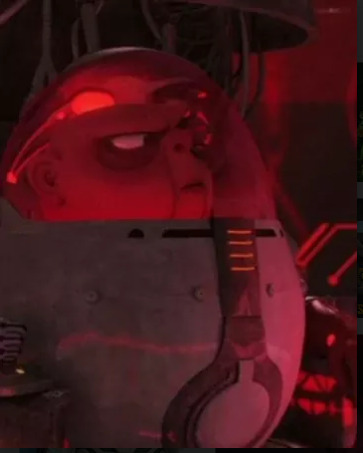
The primary species of robots that Dr. Tommy makes participate in team based sports, interpersonal relationships, jokes, goofs, and gambits. The concept of Artificial Intelligence making jokes, playing sports, and creating bonds is not unheard of, or at least, it might not be in 2080. However, my next questions make me think these robots were not AI. My questions were:
Do the robots have the concept of death?
Do the robots ever say the word ‘heck’?
To both of these, the answer was a horrifying yes.
Yes, it is confirmed, that robots on the moon say heck. The implications of this are astronomical. I will spell it out thoroughly because lockdown has given me endless time with which I can do as I please.
Heck is, of course, derived from the word hell. Hell is the counterpart to heaven, both terms used to signify the existence of an afterlife. Where there is the word heck, there are beings that believe in the afterlife.
These robots have souls.
The circumstances in which these robots die, which they are entirely able to do because of their soul, is such: The Reformatter. To simplify, the Reformatter grinds the entirety of the robots body to scrap, which it then melts together to make household appliances. This is what happens to robots who are not ‘good enough’ in society.
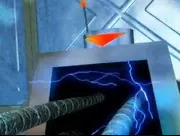
What the nightmarish fuck.
Not only do the souls of the robots face heaven and hell, they also face being reformatted to become the brave little toaster if they do not serve their society.
Their society which is made by one human
Let me emphasize this; they treat him like he is unto a god. How can they not? He created them, their world. He is their father, their everything. They even built a statue of him, holding an enormous double sided wrench which is clearly symbolic to remind them.
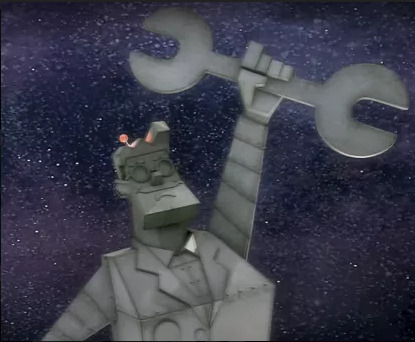
Dr. Tommy gives life, and it can be taken away.
The method of which he gives life is a puzzlement to me. I am told that our dear Dr. Tommy refers to a robots as having a ‘Heart’. This Heart is described to me as a magical piece of leprechaun gold, so the robots are able to feel.
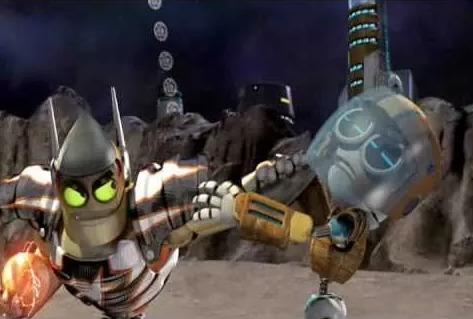
The robot Heart is likely a simplification. The show is advertised as a Family show, and must cater to the understanding of all ages, including small children. Breaching the topic of souls, mortality, and the afterlife likely wasn’t something the writers or creator were able to do. My theory is, the Heart is a future technology that can instill a soul into a robotic body,
Which, wow. Big, if true. At first I was boggling at the concept of manufactured souls being a technology that humanity could see in my lifetime, but then I remembered one of the three key pieces of knowledge I was initially given.
“It takes place in a post-war era of “world peace”"
....Throughout human history, one social class is legally subjected to inhumane treatment; Prisoners. Once you are in jail, internment camps, concentration camps, those that are keeping you there believe you have less rights as a person. Medical experimentation, slavery, abuse, forced sterilization, nothing is illegal.
And after a war like the doozy Earth must’ve recently went through, there must be a lot of war criminals. Those that were so engulfed in carnage and bloodshed, there was no way for them to reenter society. The newly forming singular government, if they had access to the necessary technology, may have used it on these criminals.
Think about it. The dust settles from an all out world war. There cannot be peace without someone to shoulder the blame of the atrocities. There must be an evil, if there is to be peace. So, the individuals who excelled in war and killing became the reason there was war and killing. These people are now less than human for what they’ve done. They can be treated as such.
I think this is when their souls were taken. As each warrior passed, their spirit was caught and kept. And then, in a classic move from 1788-1868, they transported all the criminals to somewhere they would never harm humanity again. Somewhere out of the way, remote, and it was the moon. You knew where this was going, they sent all the souls to the moon.
Along with a large amount of other people! The two scientists certainly did not build an entire moon colony on their own, and at this point, the robots were not even in production yet. The moon colony was made, and then the scientists began their work.
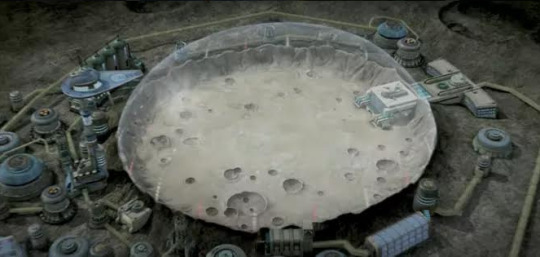
Starting with the leprechauns, who I believe were not made from the souls of war criminals. The first one may have been another scientist, the one responsible for creating the ‘Hearts’ in the first place. This is why that one knows how to create more of itself.
Then, the robots were made. There would have been a prototype, but let me focus on what the show covers for a bit.
The sports that these robots engage in is between two existing teams, complete with names, colors, and esprit d’corps. These games vary from episode to episode, some involving hang gliders, some with miniature fighter jets, some involve a battle with guns... that squirt water. The logic there is that if they are hit with the water, they rust and die. Which, okay. Right.
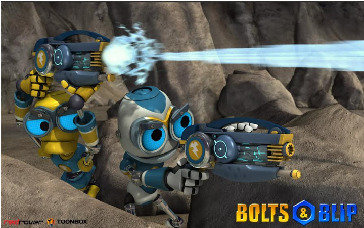
But a lot of the games and sports they play seem to be quite combat based. Furthermore, the robots seem to take to them naturally.
Not to mention, there are bomb mice and big laser guns as well. These robots are armed. Why the hell are these robots armed? Who thought it was a good idea? After all, these robots are clearly capable of malice still. Why wouldn’t they simply turn violent against the humans?
I think they did. Here’s my theory of how it went down.
Dr. Tommy begins using the souls of war criminals in a prototype of robot
The robots can recall their life on earth as humans, but are now trapped in metal vessels because their bodies have been destroyed
The robots begin reacting to the existential nightmare of being soul trapped
Some despair and destroy themselves
Some are enraged and destroy humans
Most of them, actually
Most of them turn their wrath against humans
The people who inhabited the moon, who created the cities, were suddenly under attack by the most skilled killers around.
This is when Dr. Tommy hits the kill switch for these robots. They are recycled, and maybe he even collected the souls again but maybe Dr. Blood took those ones.

These happenings left only two humans left on the moon. Dr. Tommy began making a new version of robots, who’s souls could not remember their time on Earth. Perhaps, in taking away everything about their humanity, he gave them the most innocence of anyone.
These robots now know that
Dr. Tommy is good, for he created them
They must contribute to the society Dr. Tommy has made for them
If they fail to do so, they will not only die, but go to hell
Dr. Tommy is the good scientist. He doesn’t want the robots to be used for evil, he doesn’t want them to hate each other. Not like that Dr. Blood, who encourages these robots who have no memory of who they were before and might be able to unlock those memories to become more warlike.
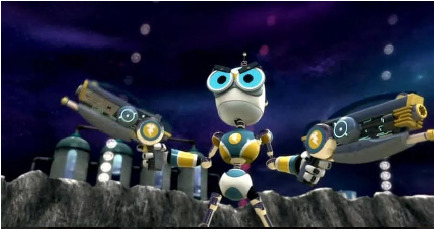
However, look at what Dr. Tommy makes them do. The robots are still using their combat knowledge, independently of their memories of war on Earth. Their knowledge is being honed and enhanced, while the repercussions of their actions are not something they are privvy to. But, Dr. Tommy is the good scientist. The robots know this, because he said so.
Or because they will be obliterated and condemned if they go against his word.
It is also worth noting that the good doctor also usually lives remote from his creations, in a little space shuttle.
In conclusion. I believe Dr. Tommy is knowingly creating an army of supercombatant robots, imbued with the souls of the most bloodthirsty war criminals, that will do his every will. He intentionally killed every human on the moon colony that he could. I fear what this will mean for the future Earth of this show.
Final notes:
These robots, once their souls memory was wiped clean, would have no gender. Gender is a construct originally created to indicate what a persons sex characteristics were. Not only is that a spectrum on humans, but robots would not be given any such characteristics, nor would the concept of gender transfer over. All the characters seem to perscribe gender to themselves though, which was not something they were given at their ‘birth’. This makes none of them are cisgender, so every robot in the show is transgender.
Further cementing my belief that Dr. Tommy made these robots for combat is that at LEAST the main characters have “super” modes, where they become even more powerful and capable of succeeding in combat. What’s the hyper-killing mode for, Dr. Tommy? What’s it for?
The humans that were killed on the moon are still somewhere, probably frozen? One joke alluded to the characters being able to purchase human body parts (a stomach) in the run of their average day. Its very possible that the human anatomy is being extensively studied by the robots. Whether this is for medical purposes, or to more accurately kill humans, or to satisfy their innate bloodlust, I do not know.
I am also told that at the end of the only season, a space ship that is also a school bus arrives on the moon! It is full of children. Which. Oh god oh no.
I understand this turned into a grimdark internet theory of a cartoon. I also believe that, without the ability to think critically, we will never be able to come to rue understanding of our own nature. It is still a cartoon. My thoughts and words should be taken with a singular grain of salt, because I am a human who is often wrong. That being said, Andrew Knight, if you ever read this, let me know what you think.
24 notes
·
View notes
Text
How to Include Autistic Women in Your Feminism
Hey, given that this is an activist post, I might be mentioning certain issues that might be triggering to some. Check the tags and stay safe. Ily. ❤️
Ever since activist and feminist Audre Lorde devised intersectionality as a way of describing the experience of multiply-marginalized women, feminism has adapted to include women of color, trans women, queer women, disabled women and religious minority women. Although white, non-intersectional feminism is still pervasive and is the dominant ideology carried on by cishet white women, a significant portion of the feminist movement has embraced the identities and diversity among various groups of women.
Intersectionality allows for us to look at the various ways womanhood affects those experiencing it, instead of just slapping one catch all experience of femininity onto all women. It lets us understand that a woman of color, for example, has less amounts of racial privilege than a white woman and must deal with the burden of specific stereotypes around being a woman of color. Intersectional feminism centers the women with multiple identities, or “intersections,” that society considers unfavorable or marginalized.
However, with all the strides intersectional theory has made in social justice circles, the plight of Autistic women is largely ignored by even the most inclusive feminist circles.
Disabled women as a broader group are often lumped together, even though cognitively disabled, intellectually disabled and physically disabled women contend with incredibly different forms of ableism. Alternatively, the feminist movement also tends to cater to physically disabled women who often have more visibility (which, granted, isn’t a lot) and acceptance than those whose minds are thought to be lesser.
It’s common in the disabled community for people to justify their humanity by asserting their neurotypicality, while erasing and oppressing non-neurotypicals. The pro-Autistic movement itself is mostly made up of women, queer individuals and people of color, and yet somehow it always ends up headed by cis white men. In both feminism and Autistic advocacy, women (especially ones with multiple intersections) are ignored and pushed to the sidelines despite typically facing greater oppression than cis autistic men.
Thus, it’s important to make sure to be inclusive towards autistic women and GNC individuals in both feminism and disabled activism. Here are some ways that I’ve compiled on how to make your feminism both inclusive and accepting as a queer, Autistic feminist.
1. Mention Autistic Women and Bodily Autonomy
Women’s rights to their bodies are an important topic to discuss in feminism, but Autistic women deal with specific challenges in regard to consent and access to care and their bodies, so it’s important to bring up these issues in your discussions.
For starters, the court case Buck v. Bell still stands to this day. The case itself took place in the early 20th century during the eugenicist movement, and the court’s ruling allowed the forced sterilization of anyone labeled feebleminded. It’s legal for parents and guardians of the disabled to sign paper and sterilize anyone under their control regardless of whether the person in question consent to it even now. This is especially unsettling for women of color, who have historically been abused by eugenicist doctors. (See The Immortal Life of Henrietta Lacks and the book Imbeciles for more information on these topics).
In the medical industry, there are also barriers Autistic women must deal with. Today, there are still ableist debates about whether Autistic and other disabled people deserve emergency medical treatment and organ transplants. Once again, this is especially bad for women of color who deal with medical abuse and malpractice committed against them in modern times.
The gist is, the most vulnerable Autistic women often don’t have the ability to consent to harmful and damaging procedures.
For transgender Autistic women, the burden is tenfold. Many Autistic trans people on social media have shared their stories about how people struggled to believe that they were trans because of their neurological difference. This makes transitional care and access much harder for GNC Autistic people and trans people, as their gender identity is viewed as a symptom.
2. Talk About Consent
Along with consent to medical procedures, there’s also the fact that Autistic women are particularly vulnerable to the whims of violence against women. Here are some ideas to mention when talking about consent.
First off, many Autistic women use alternative methods of communication. Neurotypical women can usually say an explicit ‘yes’ or ‘no,’ though they still face violence. For Autistic women who are nonverbal and communicate through AAC, in a victim blaming culture such as ours their hindered ability to consent can be used against them.
Through ABA therapy, Autistic women are also further taught that their ‘no’ doesn’t matter. True ABA therapy, created by Ivar Lovaas, is essentially legal conditioning. The aim of this psychological form of abuse is to train Autistic children into seeming more Neurotypical instead of embracing their unique neurology and changing their environment to fit their needs. These kids are taught to obey authority at all times, or else they’ll deal with the use of an aversiv e. This of course, discourages their active consent to a situation and puts Autistic women in a dangerous position.
If they are physically as well as cognitively disabled, they may not physically be able to resist or run from an attacker. In many cases, an incidence of assault is justified by the perpetrator claiming that the victim wouldn’t have had a consensual encounter otherwise because they are “ugly” or unworthy of a healthy relationship. Autistic women are often considered to be such..
Trans women and women of color, who are often assaulted more frequently than cis white, women are of course very vulnerable when it comes to this issue. As such, it’s vital to mention this at any discussion of consent.
3. Know that Toxic Femininity Affects Us More than Neurotypical Women
To preface this, I want to say that there’s nothing wrong with being feminine. I myself identify as a femme woman, out of my own personal fashion sense and aesthetic. I like being a feminine woman and wearing dresses and having long hair, though these also aren’t the only ways to be feminine, of course. Embracing femmeness does not mean that someone is servicing the patriarchy, and embracing androgyny and/or butchness also doesn’t mean said person has internalized misogyny. Everyone is entitled to the way they want to present, and feminism should be about uplifting how people choose to present themselves instead of putting down women they don’t think look “liberated” or “feminist” enough.
That being said, the patriarchy tends to enforce feminine roles on cis women and police the feminine expression of transwomen to make them “prove” they’re really trans and “sure” about being women. I like to call this “Toxic Femininity,” the way that women are pressured to conform to Eurocentric femininity regardless of how they actually want to present, but then oppressed for both their femmeness or their alternate presentation if they disregard the aforementioned. Either way, women can’t win.
Abiding by gender roles is exhausting for anyone, but for Autistic women who have limited energy to go into their daily activities and deal with sensory issues and neurotypicals. As such, gender presentation is often pretty low on our list of priorities. Autistic women are often unable to conform to society as our hindered social skills prevent us from perceiving these norms. It’s hard for us to fully conceptualize what’s acceptable and what’s not. As such, it takes extra effort for us to live up to Toxic Femininity.
With our sensory perception, certain clothes are uncomfortable for us and it’s sometimes a necessity to wear certain textures. Men’s clothing or androgynous clothing are often more comfortable, so it’s not uncommon to find us wearing those. As such, we are often labeled butch or non-femme regardless of how we actually identify our presentation. We are cast aside by Toxic Femininity.
This is of course, even more true for fat women, trans women, and physically disabled Autistic women, who’s bodies already don’t abide by the unattainability that Toxic Femininity forces us to live up to.
4. Downplay the Voice of Neurotypicals in Autistic Women’s Issues
Despite their position of being privileged oppressors of the Autistic community, most of our advocacy is done by parents and relatives of Autistic people who believe that they are more entitled to our community and voices. They are the “Autism moms” and those with blue puzzle piece signs in their backyards, constantly yelling over us.
Most of the Autism organizations are run by these people, who often don’t consult with Autistic people about the needs of our community. Even though most of them don’t think they hate Autistic people and may even share common goals with the community, they still oppress us because they’re centering the voices of the privileges instead of the voices that are affected no matter how supportive they are.
An Autistic inclusive feminist space means downplaying Neurotypical rhetoric, meaning stopping the use of hate symbols like puzzle pieces and functioning labels. Cut out the influence of ableist organizations and monitor the use of words like “retarded” in your space. This will be difficult in a pervasively ableist society, but it will be worth it in making a more united social justice movement.
It also means allowing Autistic people to have input in their own issues, and allowing them to reclaim their agency. Know that no matter how many Autistic people you know, if you’re Neurotypical, you will never truly experience being Autistic even if you know more about the condition.
5. Autistic Women Can Still be Racist, Homophobic, or Transphobic – Don’t Be Afraid to Let Them Know
There are usually 2 stereotypes Neurotypicals believe about us, and strangely enough, they’re complete opposites. We’re either hyperviolent, unfeeling school shooters to them or perfect innocent angels who never do anything wrong. Obviously, these are ableist because they assume that all Autistic people are the same, but most people tend to look at us as the latter stereotype because it’s more “politically correct” even though both viewpoints are hurtful in different ways.
As such, when Autistic people are genuinely oppressive, they aren’t held accountable. I’ve had interactions with homophobic Autistic people who accepted me for my Autism but not the fact that I was a girl who loved girls. I’ve met misogynist Autistic men who viewed me as an object and wouldn’t respect my boundaries and right to say ‘no’ to a relationship. As an Autistic white person, I myself hold institutional power over Autistic people of color and as such, am able to be racist.
Autistic people shouldn’t be given a free pass for their bigotry, and assuming that they should denies them their agency and oppresses others in that space.
Autistic women have a lot to contribute to feminism, and neurotypical women should allow them the opportunity to rise against their own oppression. Thanks for reading and for making your feminism inclusive –
Trust me, it means the world to us.
#intersectional feminism#feminist#intersectional activism#intersectional social justice#intersectionality#disability#disabled#autism#actually autistic#actuallyautistic#social justice#activism#activist#tw: misogyny#tw: malpractice#tw: violence against women#tw: racism#tw: misogynoir#tw: transphobia#tw: ableism#tw: transmisogyny#tw: ABA#ableism
245 notes
·
View notes
Text
Shoebox Adventures- the power of space in Roy Andersson’s “A Pigeon Sat On A Branch Reflecting On Existence”
In 2014, Swedish commercial-maker Roy Anderson tried to bring his school science fair project to the Cannes film festival. A series of solemn set-pieces on the human condition shot in hyper-real grey spaces that simultaneously evoke familiarity and discomfort, his odd little diorama was bound to make a storm.
Except Cannes rejected it.
But Venice let it in! And thank god they did, saving this cinematic gem from public negligence and (a mere 6 years later) bringing it to my attention! “A Pigeon”, as I will now be referring to it, is almost certainly the strangest film I have ever seen. It might also be one of the most wonderful, thought-provoking and funny films as well. Characters, plot and setting are largely absent or deliberately vague, instead thrown in the all-consuming mixing pot known as ‘mood’. But when you’re telling a story about the nuances and complexities of humanity, it seems stupid to make it like a story. Much of it is left for the viewer to assert their own personal interpretations, to feel what they feel from the film’s peculiar exhibits. Not because “A Pigeon” has set out to confuse or provoke different audiences, but because different people see life differently. And this film has something for those different views. Who knows, it might even help them live alongside one another.
As part of my recent architectural fad, I thought this would be a great chance to explore the power of spaces within films, which is probably the medium in which we consume the largest quantity and variety of architecture. What Anderson has done with his little spaces is all kinds of captivating. Natural and alien, his scenes grow and decay off the tiniest differences. Now, to work!.
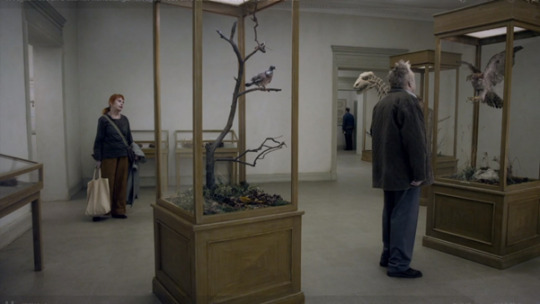
The opening scene puts everything on the table as to what we’re in for. Peering at a talcum powdered women scolding a talcum powdered man peering at stuffed birds in the world’s greyest museum, accompanied by plinky strings, you can already tell this isn’t going to infringe on The Fast and the Furious’ turf. The camera sticks 10 feet back from the ‘action’ and never once zooms or pans, so we can continually survey the scene without any distracting close-ups, leaving the characters spied-on but not fully known. The open doorways and windows are everpresent throughout the movie, a clever trick to alleviate feelings of claustrophobia. This also serves to give us a view to equally stately goings-on in the background, which helps to create Andersson’s diorama world. Every wall is flat in colour and texture, the lighting uniformly gloomy with no hint of natural light or shadow. And the cages that hold the taxidermy are metaphors for our cages of loneliness in the modern world, but you knew that already.

This hospital scene starts out as static, a painting-like arrangement of a classic scene, the children witnessing the gradual passing of their mother. Andersson keeps it uncluttered by having the dialogue occur two doorways away.
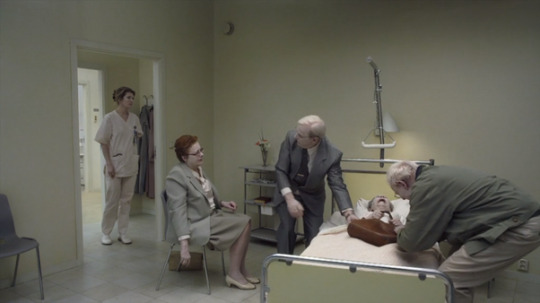
And yet after pleasantries are dispatched and pretence discarded, the whole scene swirls like Vertigo; the brothers contort, the sister slumps in her chair, the presumed-still body of the mother’s body squawks out in alarm as her bed is dragged sideways across the room. We do not zoom in to see her anguished face, making her all the more powerless and the viewer confused at what to feel. The nurse arrives silently at the threshold, hesitant to cross into this family’s hysteria. She watches the painting come to life and ruin itself, just as we do. The notion of characters watching characters is one that Andersson returns to a lot in “A Pigeon”, which ultimately provides a heavy dose of the film’s realism. In traditionally-shot movies, the two-way dialogue close-ups obscure the silent characters from our interest. Andersson lets us see them gawp, knowing we do too.
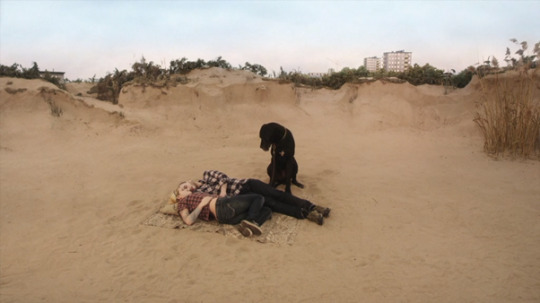
A romantic getaway might seem like a departure from the film’s predominantly urban setting, but whilst the sand and soundtrack provides the impression of a beach-scene, we are actually in another of Andersson’s dioramas. The intimacy of the couple is uncomfortable, and not just for the man’s awkward movements or their judging dog. The wall-like dunes rise up, obscuring the horizon as a pair of far-off high rises intrusively leer into shot. The sky is a pastel blue, withholding any sense of time or importance on the moment we’re presented with, the mutt our audience sleeper agent who stiffly watches it unfold.

The closest the film gets to any main characters are a pair of grey-clad salesmen who potter about the scenes with mixed financial success. Throughout the film we get to know them, and thus Sam and Jonathan carry the largest targets on their back for Andersson’s gentle ridicule, here pictured bursting into the bar like outlaws into a wild-west saloon, in which they explain that they’ve gotten lost looking for a mythical shop named ‘Party’. The gorgeous painted background, viewed through a window, is our first glimpse of a horizon- a grey/green wasteland dominated by gargantuan transmission towers. our heroes have traversed this wilderness, by foot or car we are never told, to find the Party and reap the rewards! Unfortunately for them such a place does not appear to exist, and fortunately for us they are cut off from their usual sales pitch by the arrival of the army of King Charles XII.
You need to go and watch it!
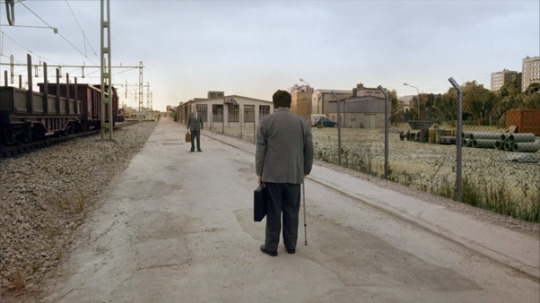
Sam and Jonathan’s spaghetti western (perhaps Swedish meatball western?) journey is revived somewhat later, with what looks like a briefcase-wielding standoff inexplicably located next to a railway. This normally charged setting is relieved of all potency by their slow hobbling around the mid-ground, exchanging insults and emptying briefcases. Which makes it more pathetic, more silly and more real. Probably the three words I’d use to describe the film.

The cruelty sequence of the film begins in a stark grey laboratory. A monkey is hooked up to electrodes and shocked according to a time. The scientist talks vapidly on the phone. In the room behind another technician feeds the remaining inmates. The monkey is closer to the camera than almost any other character through ‘A Pigeon’, close enough to see it writhe. Out the window are more grey high-rise buildings, now somewhat more suspicious and responsible for the monkey’s torture. Andersson’s world is the same palette and yet it’s ever-changing, the mood altering with each new skit. The monkey has nowhere in the film to escape to, you can’t imagine a happy ending for it and thus it’s the most blatant moraliser of the film (until the next scene).

The scene in question witnesses African slaves forced by British colonial soldiers to march into a giant cylindrical drum with horns protruding out. It’s then set alight, and we squirm as it spins, implying the frantic scrambling of those inside to produce a resonant rumble while we watch from a safe distance. I won’t spoil what happens next, but it’s sufficiently sobering.
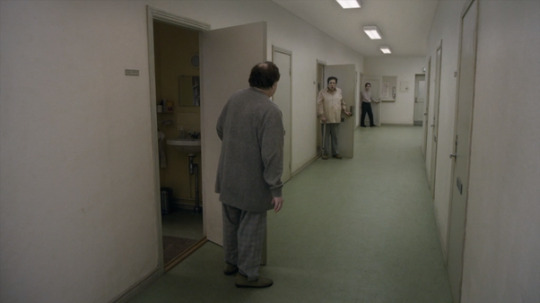
Waking from this horrible dream, Jonathan wails to Sam to make sure the viewer got the point the point of this sequence- “Is it right to benefit from the pain of others?”. Andersson makes his plea the more pathetic and powerful by giving us a view to his sink and mirror, the latter a reminder of his role in the pain.
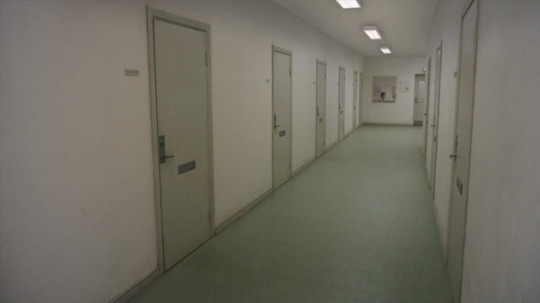
Once Jonathan is told to go back to sleep, the camera stays resolutely on the corridor. It is a bizarre space. The flat doors defy depth, the corridor is long yet finite, grubby yet sterile, lonely yet constantly surveyed by the permanently grumpy security guard.
i hope you enjoyed this dip into “A Pigeon”, and I say dip because there’s about 39 scenes in total and I wasn’t going to do all of them (for free *wink wink*). I thoroughly recommend that you watch this film (and currently you can for free on all4 in the UK) and then maybe re-watch it two more times. You may not like much of it, some of it or most of it. But I think you will love part of it. And that can be your bit of it, to take to parties and share with everyone else. Because like the hokey cokey, that’s what it’s all about.
2 notes
·
View notes
Note
Don't forget the Garrus analysis!
There’s no Shepard without Vakarian: An analysis of Garrus’ characterization in the Mass Effect franchise
Oh yes, thank you, Mun! During yesterday’s stream I commented I could write an analysis on how Garrus’ character arc is in many ways unusual, both within the Mass Effect franchise’s brand of storytelling, and in the broader scheme of how narratives tend to characterize principle personalities. Most main characters are given a significant arc that grows them greatly as an individual. By the end of the tale, they have actualized into someone with more experiences, abilities, and integrity. They stand on their own stronger than before. Garrus’ arc, interestingly enough, focuses less on him growing by himself, but rather him growing closer to Shepard.
A more typical characterization arc is found for most Mass Effect squadmates (especially those introduced in ME 2). It’s brilliant - large plot threads from major political scuffles, to individual personality plot threads of character internal conflict - are given arc, development, and wrap-up by ME 3. Mainly, squadmates are given a central conflict that is developed and resolved by the end of the storyline. To give a few examples:
Grunt is introduced with the problem of needing identity. He needs to become actualized as his own, personal krogan. By joining Clan Urdnot and leading the Aralakh Company, he becomes that krogan with a proud, personal, found identity.
Mordin’s character arc is wrapped around his complicated, conflicted logic and emotions regarding the genophage - whether it was, in fact, the correct choice to make. As much as his emotions and logic mostly agree that the second genophage was the correct move, his internal discomfort suggests that he’s not as settled in this choice as he should be. He’s still struggling. His logic and emotions come to a common goal to cure the krogan genophage in ME 3, leading him to internal peace. He goes from someone who sterilized the krogan, helping continue the collapse of krogan civilization… to their hero.
Miranda’s arc is focused around struggles with her abusive father. In the end, she can help her sister and stop Mr. Lawson once and for all.
Jacob struggles with the question of whether or not allying with a shady organization like Cerberus is okay so long as their mission goals are profitable and get the job done. His suspicions in ME 2 lead to worse experiences in ME 3; he leaves the organization and puts behind this conflict once and for all.
Wrex’s arc is about becoming a revolutionary leader. Shepard meets him after he gave up leading a small krogan clan. But he becomes reinspired to try to build his people into a stronger civilization, a stronger future.
Jack is introduced with emotional scars from an abusive past. As a child she was abused and exploited for her biotics. In the end, Jack helps nurture other biotic children into a greater future.
And so we can go through almost all squadmates this way: Ashley / Kaidan regarding trust, Samara regarding her Ardat-Yakshi familial legacy, Thane regarding his family and illness, EDI regarding what it means to be a sentient non-organic, etc. Characters are given a central problem, which they grow through and overcome.
But Garrus, I feel… is a little different.
Garrus’ arc is centered around the idea “There’s no Shepard without Vakarian.”
Now, it’s true Garrus has a few overarching problems he needs to handle throughout the franchise. It mainly involves his sense of enacting justice outside the scope of regulations. In the first game, he wants to hunt down Dr. Saleon, who got away because C-Sec regulations forbid Garrus from making risky capture moves the first time. In the second game, Garrus wants vengeance for Sidonis’ betrayal. Several times, Garrus plays a turian Robin Hood-esque character: he skirts the law and does his own vigilante thing to enact justice and punish immoral lawbreakers who have harmed others.
The thing is, these incidences are framed secondarily to Garrus’ main narrative contribution. These narrative arcs are used to reinforce Garrus’ attachment to Shepard.
Garrus does learn and grow based upon how Dr. Saleon and Sidonis are handled, yes. He’ll reach different conclusions depending upon whether you take Renegade or Paragon dialogue choices, but regardless, Garrus takes away these incidences as life lessons... life lessons pulled to him largely by Shepard’s sense of justice. Results of the Dr. Saleon mission come from Shepard’s guidance and philosophy, ideas that Garrus take to heart and mull over. The same sort of thing happens with Sidonis. Shepard’s interactions in these missions influence how Garrus thinks. He reflects upon the missions and (no matter what path players take) ultimately reaches the conclusion Shepard has a point. He aligns his thinking more with Shepard after each incident. Thus, Garrus’ experiences on the missions with Shepard aren’t about Garrus growing beyond a problem… so much as it leads him to become more synced with and loyal to Shepard.
Even the problem of Garrus’ imperfect relation with his father ultimately ties up to him building a bond with Shepard. In the first game, Garrus mentions that his father didn’t approve of Garrus taking Spectre training, so Garrus found himself as a C-Sec officer instead… albeit one who didn’t play by the books as his father did. That leads him to be interested in working with a Spectre and leaving C-Sec... all driving him to Shepard. Garrus does eventually go to his father by ME 3 - a surprising development - and tell his father about his ventures and the upcoming Reaper threat. Garrus gains his own task force to handle the Reapers and lead… which pulls him back into the central war efforts with Shepard. He’s yet again a squadmate with humanity’s first Spectre. Everything Garrus does ultimately draws him back to the Normandy.
All of Garrus’ problems in 1 and 2 are written to build that bond between Shepard and Vakarian. It’s fascinating - his character growth arc isn’t about one specific personal problem to characterize through, so much as it is about him aligning with someone else.
In this sense, the Shadow Broker’s dossier on Garrus is curious commentary on his characterization arc. The dossier begins:
Former C-Sec officer. Exceptional tactical and team-building skills. Leadership potential overshadowed by Shepard. Unlikely to fully develop under Shepard’s command.
Now Garrus does gain and expose these skills solo. He creates his team on Omega. He directs forces during the start of the war with the Reapers. But that is never where he fully actualizes, fully shines. Garrus being with Shepard is never narratively shown as a limitation, but contrarily, Garrus apart from Shepard is where he is shown to be weakest and most out-of-his-zone.
Characters out of their element can be one means of growth - it’s hard to grow unless you’re out of your comfort zone, after all - but it can also signify they’re not where they’re supposed to be. The latter is primarily how Garrus’ time apart from Shepard is depicted. If anything, his experiences on Omega worsen him into someone more emotionally unstable, hurt, and raw. And instead of it being a time where Garrus notably actualizes, it feels like a somewhat stagnant period of his life, where he’s living active inactivity, trying to figure out what to do now that Shepard is dead. Shepard reuniting with Garrus on Omega is one where Garrus is in a tight and unpleasant spot. He demonstrates he can lead and build a team like Shepard, but his experience also isn’t the one where he is depicted at his best and most heroic. He gains more motivation, resolve, and heroics when he joins the suicide Cerberus mission - he’s not just picking off villains on Omega, but now he’s out to save every human colony.
Where Garrus is depicted as his best is with Shepard. Maybe it’s just me, but I suspect that many fans get excited every time Garrus returns to the squad because they associate him with that friend always at Shepard’s side. He’s the bud Shepard can always count on. And over and over again, throughout the franchise, Garrus says some great quotes about his siding with Shepard. One of my favorites comes from the start of 2:
G: Frankly I’m more worried about you. Cerberus, Shepard. You remember those sick experiments they were doing?S: That’s why I’m glad you’re here, Garrus. If I’m walking into hell, I want someone I trust at my side.G: You realize this plan has me walking into hell too. Hmm… just like old times.
And then there’s Garrus’ character farewell in ME 3 before the final London charge. Most of these farewells bring up the central point of the character’s conflict in some way or another - for instance, Grunt thanking Shepard for taking him out of the tank, Samara mentioning the monastery where her final daughters have lived. It’s the final wrap-up to the story we’ve experienced through each squadmate. It’s to note that Garrus and Shepard’s conversation is not centered on justice, ruthless calculus, Garrus’ father, Sidonis, regulations, or any of Garrus’ other side-struggles. Garrus and Shepard focus the conversation on their friendship. On supporting each other. They talk about them being together - be it here on Earth, or up in the afterlife:
G: Shepard. So I guess this is…S: Just like old times?G: Heh. Huh. Mmm. Might be the last chance we get to say that.S: You think we’re going to lose?G: No, I think we’re about kick the Reapers back into whatever black hole they crawled out of. Then we’re going to retire somewhere warm and tropical and live off the royalties from the vids.S: I wouldn’t know what do with all my time. Neither would you.G: Sign autographs?S: We haven’t won yet.G: James told me there’s an old saying here on Earth - “May you be in heaven half an hour before the devil knows you’re dead.” Not sure turian if heaven is the same as yours, but if this thing goes sideways and we both end up there, meet me at the bar. I’m buying.S: We’re a team, Garrus. There’s no Shepard without Vakarian. So you better remember to duck.G: Sorry, turians don’t know how. But I’ll improvise. And Shepard, forgive the insubordination, but this old friend has an order for you: Go out there, and give them hell. You were born to do this.S: Good-bye Garrus. And if I’m up there in that bar, and you’re not, I’ll be looking down. I’ll always have your back.
Between these two conversations, Garrus and Shepard literally talk about going through heaven and hell together. They connect through old times and forge into new times together, onward and onward. And there is an undying support between the two. They make each other stronger.
The Shadow Broker is sort of right that Garrus’ leadership potential overshadowed by Shepard. Garrus gains respect from teams on his own, but he never rises to that legend Shepard does by himself. That said, the Shadow Broker is also wrong that Garrus development is hindered by being around Shepard. Garrus being with Shepard is the best that Garrus is. The point of Garrus narratively is to be with Shepard, and that’s where he makes the most memorable storytelling difference. Garrus’ narrative is about being Shepard’s loyal best friend (or lover, if you romance him) - the second-in-command whose support is critical to the Milky Way’s salvation.
Garrus’ story isn’t centralized about how to handle justice outside regulation. Garrus’ story isn’t one about deciding what to do with gray morals and ruthless calculus, as much as he speculates about that topic. Garrus’ story isn’t one of getting out of Shepard’s shadow. It’s a story about him syncing with Shepard’s shadow.
The idea that there’s nothing sweeter than his loyal friendship.
#mun3001s#long post#Garrus#ME#Mass Effect#ME2#ME 2#Mass Effect 2#ME 3#ME3#Mass Effect 3#Garrus Vakarian#my analysis#non-UT#female shepard#Commander Shepard#ask#ask me
161 notes
·
View notes